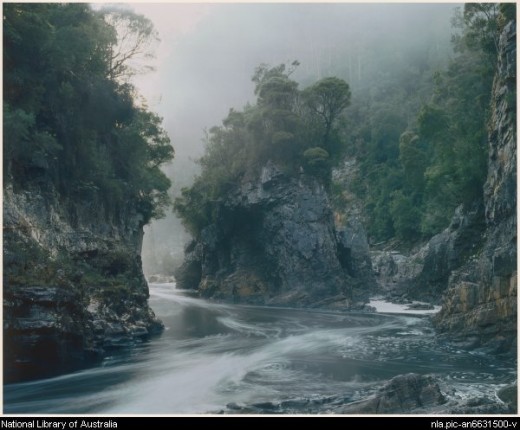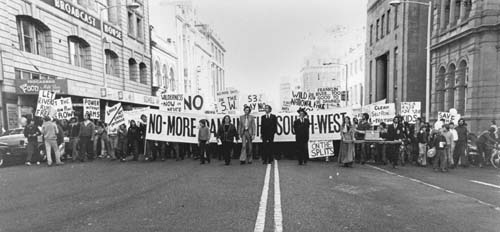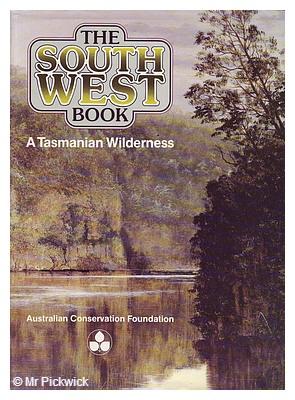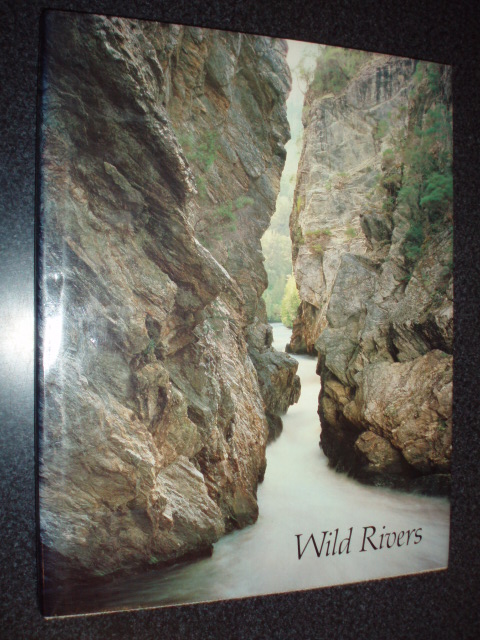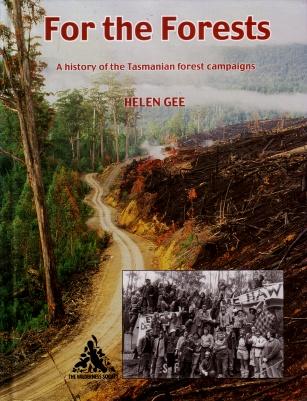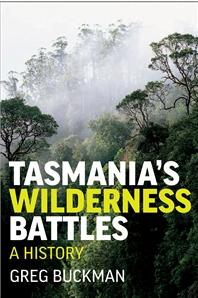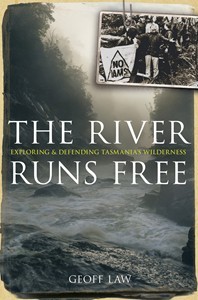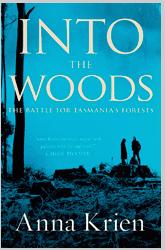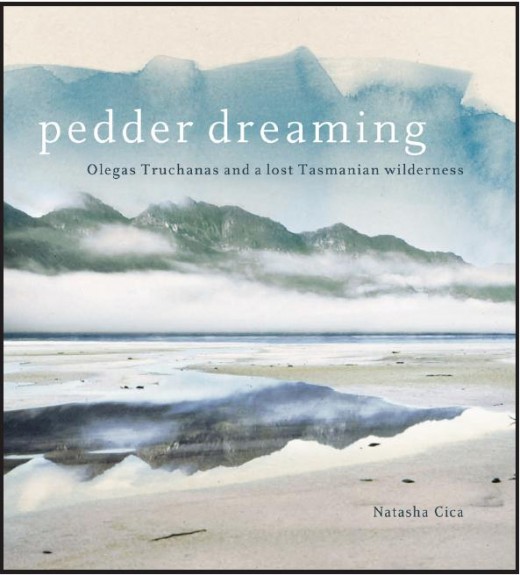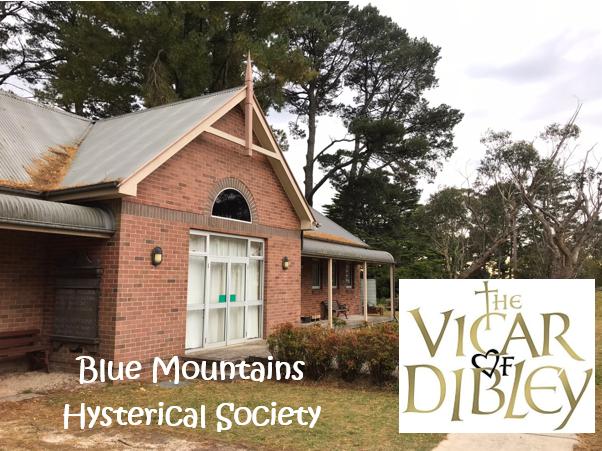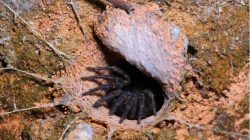x Tasmania’s Conservation Background
.
In order to begin to appreciate the cultural depth of Tasmania’s ‘age-old conflict‘, time deserves to be invested in reading important books on Tasmania’s recent past, and each is a riveting read.
Franklin River Rally in Hobart, Tasmania (1982?).
.
1. ‘The South West Book: A Tasmanian Wilderness‘, compiled by Helen Gee, Janet Fenton and Greg Hodge in 1978, published by William Collins Pty Lts and The Australian Conservation Foundation, [Read More]
.
‘The South West Book – A Tasmanian Wilderness is a book published by the Australian Conservation Foundation in 1978 during concern following the damming of Lake Pedder in Tasmania. It was edited by Helen Gee and Janet Fenton with assistance from Greg Hodge and Artwork directed by Chris Cowles. Of 308 pages, it was the most comprehensive book concerned with a region from all aspects of its kind in Australian publishing at that time. With over 40 authors of 50 sections as well as chronology of events and bibliography the book covered industrial issues, conservation issues, as well as the development of the bureaucratic and political status of what eventually became the South West Tasmania World Heritage area.’
.
Foreword:
‘This remarkable book presents a compendium of information about Tasmania’s South-West, the people who once inhabited it, its geology, and geography, its trees and marshes, its rivers, the animals and birds which abound there, and the threats of destruction by forestry, hydro-electric development, mining and tourism. The whole makes a well-told and fascinating story, which is bound to win support for those who recognise the need to keep it undeveloped, whatever the cost.
Geologically, the South-West is ancient, but in terms of human presence it is recent. While the Aboriginal inhabitants of Tasmania lived there for 20,000 years of more, they penetrated into the South-West perhaps less than 3,000 years ago. These decent, peaceful people lived in villages of huts, cremated their dead, and fired the bush and forest to drive out animals for food, changing greatly the original ecology of the region. Once plentiful, and able to eke out a reasonable subsistence in that infertile region, theye were wiped out by the white government, which herded them together in settlements where they could become Christians and die of the white man’s diseases.
Pursuit of the Huon pine, fine-grained and easily worked, brought Europeans to the South-West early in the 1800’s. Later, the loggers came back in earnest, and stands of ancient Huon pine would have been wiped out but for the efforts of a few enthusiasts, like Truchanas, who persuaded the Government to reserve a small area.
Towards the end of last century, some keen bushwalkers discovered the South-West, the challenge of its arduous tracks through wonderful scenery and true wilderness. Chapters in this book describe all these things with understanding and sensitivity. More technical sections on the natural environment of the region, its geology, climate and climatic changes, its fauna and flora, its fishes and insects, will interest both naturalists and laymen. But it is the final chapters on man’s use of the South-West which aroused my keenest interest, for therein lies the key to its preservation.
The case against extension of forestry is put forcibly by experts. The area has considerable further hydro-electric potential, but it is shown that this is fatal to wilderness. Mining and quarrying could result in similar damage. But one of the greatest dangers is tourism. It is possible for preservation of great beauty to exist with highly developed public access, as in Yosemite National Park in California. However, roadways for cars and buses, motels, ski-lodges, and ski-lifts, and large-scale organised bushwalking, are not compatible with biological wilderness.
It is clear that no action should be taken which would prejudice the wilderness character of South-West Tasmania. This means that strong and courageous political decisions are needed now to establish the wilderness areas, and to ensure that there is no flouting the law. The State would have to forego the economic returns which could result from development, but the region is national, rather than a purely State, responsibility, so that all Australians should contribute through the Federal Government, to the expenses associated with every aspect of its preservation.
I am confident that this book will help greatly to promote that understanding of our heritage which will result in the conservation measures necessary for the South-West to remain an area of wilderness.’
~ Sir Mark Oliphant Past President Australian Conservation Foundation.
.
2. Bob Brown’s 1983 book ‘Wild Rivers‘ with photographs by Peter Dombrovskis, available from Mr. P. Dombrovskis, P.O. Box 245, Sandy Bay, Tas. 7005.
‘An account of the story on the conservation campaign to save the Franklin and Gordon Rivers from hydro-electrical damming and flooding, written by the campaign leader, now national senator, Bob Brown.
.
.
3. Bob Brown’s 1986 book ‘Lake Pedder‘ , published by The Wilderness Society [ISBN-10: 0908412215, ISBN-13: 978-0908412211]
.
.
4. Helen Gee’s 2001 book ‘For the Forests: A History of the Tasmanian Forest Campaigns‘, published by The Wilderness Society, Inc. [Read More]
.
‘Oral history of the Tasmanian forest campaigns. Compilation of over 100 interviews of artists and activists, politicians and environmentalists such as Senator Bob Brown and Alec Marr, Campaign Director of the Wilderness Society. Chronicles strategies, protest marches, and achievements of campaigns. Foreword by palaeobotanist Mary E White. Copiously illustrated, includes appendices, maps, chronology, bibliography and index. Author is a Tasmanian writer and environmentalist, writer of ‘The South West Book: A Tasmanian Wilderness’.’
.
Back Cover:
‘People love and cherish the magnificent diversity and extent of the temperate forests of Tasmania, Australia’s island state. So much so that when the forest exploitation became senseless and obscene they came from all over the world to join the protest. This book records the peaceful direct actions that became household words around Australia: Jackeys Marsh, the Lemonthyme, Farmhouse Creek, Wesley Vale, the Tarkine, Mother Cummings…
‘For the Forests‘ is oral history at its best: over 100 activists, artists and concerned citizens tell the people’s story with a fresh and graphic candour. They are insistent, obstinate and unrelenting in their grassroots’ outrage. Helen Gee and designer Marie Robb have honed the yarns and the memorabilia into an innovative record to inspire a new generation.
Tasmania is a life-changing, empowering island because it is a stronghold of last wild places with its rich biodiversity echoing an ancient past. In this new millennium Aboriginal people are wanting to share their insights; and their knowledge is priceless.
Birthplace of Green politics and of The Wilderness Society in Australia, Tasmania is pivotal in world environmental politics. This book is a solid resource of stories and strategies; these are the great forest activists who have pioneered peaceful protest. It is a message for the young and the daring as well as for those in the board rooms and the parliaments around the world. It is a call to action for the last great forest wherever they may be.’
.
.
5. ‘The Valley of the Giants: A guide to Tasmania’s Styx River Forests‘ (2004) by Bob Brown, Geoff Law and Vica Bailey, published Berkelouw [Read More]
.
‘Tucked away in Tasmania, the Styx River flows down to the Derwent. Its upper valley of twenty three thousand hectares, harbours the tallest measured trees in the Southern Hemisphere. Vica Bayley has revised Bob Brown’s 2001 text to provide the lastest details about access, walks and the logging of the valley.’
.
.
6. Bob Brown’s 2005 book ‘Tasmania’s Recherche Bay‘ (with photography by Peter Dombrovskis), published by The Green Institute [Paperback, 56pp, colour, ISBN 0 646 44899-4, rrp $17.50] [Read More]
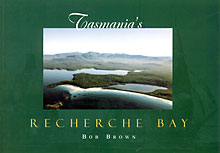
‘Picture the scene when the last tree on Easter Island was to be felled. The technocrats would have said “Don’t worry — science will find an even better substitute.” The religious would have assured everyone that God would continue to provide, while the bureaucrats would report that since research was incomplete, a ban on logging might be premature. The landowner would have asserted his right to do as he wished with his own property, while the man with the axe would be saying “What about my job?”
That’s not an original thought; in fact, I pinched it from Jared Diamond. It’s a forceful image and one we have just enough time left to learn from.
The Easter Islanders destroyed their isolated environment in the service of a pitiless religion which culminated in an insane orgy of competitive statue-building. We’re well on the way to doing the same thing in the service of an equally pitiless corporate creed that puts profit before all else.
The powerful images of the late Peter Dombrovskis were instrumental in curbing a seemingly all-powerful Hydro. Now Bob Brown, again through pictures, has given a voice to Recherche Bay, which is threatened by the seemingly all-powerful Gunns, the rapacious woodchip giant that wields such awesome power behind the scenes in Tasmania and is the ultimate emptor behind yet another State-sponsored logging outrage.
A tender spot
But they’ve trodden on a spot more tender than they guessed. The vehemence and volume of the protest surprised loggers and government alike and grew as more people became aware of the unique importance of the site of a peaceful encounter between the Lyluequonny people and an 18th century French scientific expedition.
Bob Brown hired an aircraft and photographed the tranquil beauty of the place for this book. It’s a slender volume but it proves the old saw that one picture is worth a wealth of words; it is beautifully designed and Bob’s photographs are augmented with maps and drawings of the Lyluequonny by the expeditioners; the result is a powerful and passionate statement.
Within its brief compass the text lets Recherche Bay tell its own tale through quotations from the French explorers, glimpses of the fragile flora and fauna and a concise account of the controversy.’
~ Fred Baker.
.
.
7. Greg Buckman’s 2008 book ‘Tasmania’s Wilderness Battles: a history‘, published by Allen & Unwin [Read More]
.
‘A fascinating account of the recurring fights over Tasmania’s natural resources that have torn its people apart for three decades. Tasmania’s old-growth forests, its wild, untamed rivers and its remote, rugged mountain peaks are etched in the minds of most Australians but these wilderness areas have been the focus of bitter conflict between government, big business and environmentalists for the past 30 years.
Although told mostly from an environmentalist’s point of view, this book is a factual record of events. Beginning in the 1970s with the flooding of Lake Pedder, it takes the reader through the heady days of the Franklin River blockade and the more recent battles for Tasmania’s old-growth forests, culminating with the controversial proposal for the Gunns pulp mill in the Tamar Valley. Unfolding events reveal something of how politics is done in the island state and why a climate of suspicion and mistrust persists among the various interest groups. These battles also have had ramifications for the whole of Australia. They have played a defining part in the shaping of the Green party as well as The Wilderness Society and The Australian Conservation Foundation.
Never before has Tasmania been examined through the prism of conflicting values over wilderness. This approach shows what influence this single issue has had upon Tasmania’s recent history.’
.
.
8. Geoff Law’s 2008 book ‘The River Runs Free: Exploring and Defending Tasmania’s Wilderness’, published by Penguin Australia [Read More]
.
‘Geoff Law first rafted the dangerously beautiful Franklin River on a whim. He was inexperienced and in a leaky raft, the weather was treacherous, and his travelling companion was someone he didn’t know and who hated the place. But that eventful trip drew him into the historic battle to save the Franklin from being dammed. It was a struggle that brought down a federal government, and one whose ecological reverberations, twenty-five years on, are more commanding than ever.
In The River Runs Free Geoff Law gives a lively and witty account of that flagship campaign, weaving it around stories of his wilderness travels. Drawn since childhood to wild places, he is an experienced solo bushwalker, one who can never resist a challenge. He writes powerfully about the connection between humans and landscape, the source of inspiration for his life’s work. Travel with him and you never know what’s coming next – but you’ll arrive exhilarated.’ [Readings Review]
.
.
.
9. John Chapman’s 2008 5th edition book of ‘South West Tasmania‘, a walking guide illustrated with photos, and map of walking tracks. [Read More]
‘The 5th edition contains 224 pages, 141 colour photos, 22 maps, ISBN 978 1 920995 03 4, suggested retail price $37.50.
.
The new edition is a major upgrade from earlier editons – the guide has 224 pages (last edition had 192) and has 141 colour photographs (previous edition had 75 black and white photos). New additions are colour topographic maps for all major tracks and routes and gradient profiles for all major tracks and routes. New areas included are the Picton Range and also an expansion of brief notes of harder or lesser known walking routes. Overall the new guide describes almost 200 days of walking (the previous edition described 125 days).
Previously published in 1976 (note form on A4 paper), 1978, 1983, 1990 and 1998. Covers all the main tracks and routes in South West and Wild Rivers National Parks in Tasmania. This covers the southern half of the Western Tasmania World Heritage Area. Track notes for the northern half are in another guide, Cradle Mountain Lake St Clair National Park. Contains comprehensive track notes, brief background notes on history, botany and geology, comprehensive planning and preparation notes and access details.
Walks described are South Coast Track, South West Cape, Port Davey Track, Huon & McKays Tracks, Precipitious Bluff (Southern Ranges), Picton Range, Federation Peak and approaches (Eastern Arthurs and Farmhouse Creek), Western Arthur Range, Mt Anne, and Frenchmans Cap. Included as brief planning notes are the West Coast (Strahan to Port Davey), the Frankland Range, the Denison, Spires and King William Ranges and also a new section of Other Routes which includes Mt Hopetoun, Old River to Federation Peak, White Monolith Range, Vanishing Falls, Mt Norold and the Prince of Wales Range.’
.
.
9. Dr Greg Ogle’s 2009 book ‘Gagged: The Gunns 20 and other law suits‘ Anna Krien’s 2010 book ‘Into the Woods: the battle for Tasmania’s Forests‘, published by The Wilderness Society Inc. [Read More]
‘This is the inside story of the defence of the Gunns 20 case, and of a number of other similar, but no less dangerous, law suits. In a personal account of more than a decade defending so-called “SLAPP suits” over the Hindmarsh Island bridge, battery hens and the Tasmanian forests, “bush lawyer” Greg Ogle tells the history of the cases and their impact on the defendants and the community. This passionate portrayal illustrates the effect of such litigation on free speech and political protest, and makes an eloquent call for law reform to ensure that these incursions on civil liberties never happen again.’
.
[Greg Ogle’s online discussion]
.
.
.
10. Anna Krien’s 2010 book ‘Into the Woods: the battle for Tasmania’s Forests‘, published by Black Ink [Read More]
.
‘For many years, the Tasmanian wilderness has been the site of a fierce struggle. At stake is the future of old-growth forests. Loggers and police face off with protesters deep in the forest, while savage political games are played in the courts and parliaments.
In Into the Woods, Anna Krien, armed with a notebook, a sleeping bag and a rusty sedan, ventures behind the battlelines to see what it is like to risk everything for a cause. She speaks to ferals and premiers, sawmillers and whistle-blowers. She investigates personalities and convictions, methods and motives. This is a book about a company that wanted its way and the resistance that eventually forced it to change.
Into the Woods is intimate, intrepid reporting by a fearless new voice.’
.
.
.
11. Natasha Cica’s 2011 book ‘Pedder Dreaming: Olegas Truchanas and a lost Tasmanian wilderness ‘, published by UQP [Read More]
‘Olegas Truchanas stands quietly among the twentieth century’s most influential wilderness photographers …subtly but surely he crafted the modern frame through which we now interpret the beauty and value of Tasmania’s wild places.
Olegas Truchanas, a Lithuanian émigré, is remembered not only as one of the fathers of Tasmanian wilderness photography, but also as a conservationist, a thinker and an adventurer. Devoting years to campaigning passionately to save Lake Pedder from its eventual
flooding in 1972, Olegas and those closest to him – including members of a small group of Tasmania’s landscape artists known as the ‘Sunday Group’ – paved the way for later Tasmanian conservation successes.
In a beautifully designed new book, Pedder Dreaming: Olegas Truchanas and a lost Tasmanian wilderness, author Natasha Cica quietly evokes the man, the time and the place. Having long been inspired by Truchanas’ elegant and generous spirit, as well as those closest to him, Cica spent a signi”cant number of years researching and writing Pedder Dreaming. According to Cica, ‘Olegas’s enduring legacy and that of the Sunday Group stretches far beyond the photographic, the political or even the personal’.
In retelling their moving story, Cica highlights the values underpinning the art and activism of Olegas and his friends, offering a departure point for readers to consider basic questions about how they choose to live their lives. As former Premier of Tasmania David Bartlett comments in the book, ‘Back then the voice they used was about beauty and nature. Today we use statistics and numbers and residues and outfalls, and how many grams of dioxins, and how many jobs. Perhaps the content of the conversation has changed as well as the way in which it’s delivered – we have a much more content-hungry media cycle that really just wants a simple grab. I equate it almost to the death of the political speech as an art form – perhaps Truchanas and his crew were the equivalent of Chifey’s “Light on the Hill” speech.’ (page 227) Stunningly illustrated with original Truchanas photographs from the 1950s, ’60s and ’70s, and artwork from the Sunday Group (many of which have not previously been published and are still in private collections), Pedder Dreaming captures the raw beauty, vulnerability and o$-times brutality of the Tasmanian wilderness. This exquisite keepsake and inspiring artefact will appeal to anyone interested in Tasmania, in wilderness areas and beautiful landscapes, in our connections with the environment, in progressive political movements, and in our culture.’
